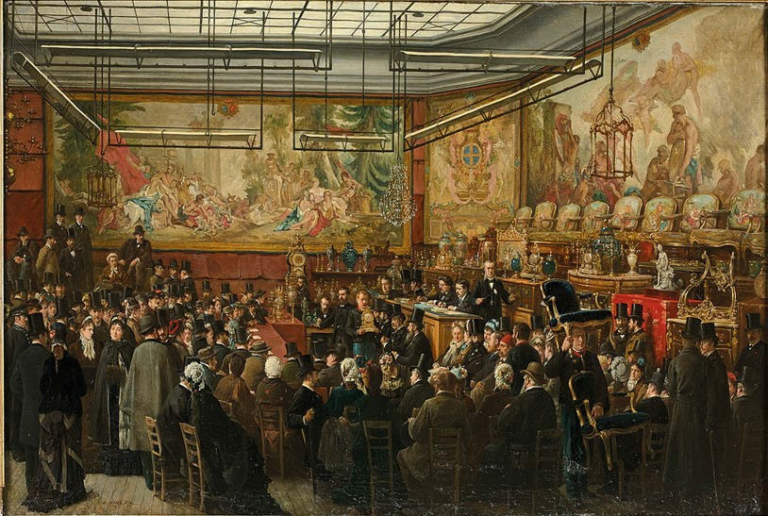The attraction and excitement of an auction are well known, with tantalizingly enticing prices for often rare and desirable objects and collectibles. In this day and age, this is especially true, in the backdrops of mass-market consumerism and uber-wealthy collectors’ lust to obtain one-of-a-kind and unique art and objects at attractive rates. However, the business of auctions has existed for far longer than one may think — with the first recorded auction happening over 2,500 years ago.
The Ancient Beginnings
Around 500 BC, the Greek historian Herodotus was the first to mention the auction procedure, reporting that it was used in Babylon to sell women for marriage. At that time, women were considered property and were auctioned off. The auctioneer graded women based on personal judgment of their attractiveness, and that determined the order in which they would be sold. The only way to sell a daughter as a wife to another man was through an auction. However, If a couple did not get along, there was a return policy in place.
The Roman Empire’s auctions used to dispose of property and products were known as the Atrium Auctionarium. Roman troops also employed this approach to distribute the spoils of war, which would have suited their triumphant sentiments. During these times, an auction was indicated by a spear driven into the earth. Nothing, even individuals, was off-limits for sale. Slaves seized by opposing forces were auctioned off, and the revenues were used to fund future war operations. Additionally, citizens who were in debt might use an auction to sell their assets. Moreover, the very word auction comes from the Latin word “auctus,” which means “increasing.”
The Birth Of Modern Auctioning
Auctions were mentioned in the Oxford English Dictionary for the first time in 1595. In the late 17th century, the London Gazette is claimed to have reported the auctioning of artwork at coffeehouses and pubs around London. The world’s oldest auction house, Stockholms Auktionsverk, was founded around this time —- in 1674 in Sweden. Sotheby’s is the world’s second-largest auction house, having held its inaugural auction in 1744. Christie’s, the world’s largest auction house, was founded in 1766.
Christie’s
James Christie, a Scotland-born UK auctioneer, was the one to found Christie’s auction house on December 5th, 1766, in London, England. It started as a studio for prominent artists’ auction sales and evolved into something much bigger. Namely, after handling a number of important art auctions, such as the one where sir Robert Walpole’s painting collections were sold to Catherine the Great of Russia in 1778, Christie’s quickly established itself as a renowned auction house. That led to capitalizing on London’s newfound prominence as a major international art trade hub during the French Revolution.
Following his father’s death in 1803, James Christie II, a specialist in ancient Greek and Italian art, took over the business. It stayed as a private company until 1973 when it went public, and then it was bought by Francois Pinault, a French businessman and a mega art collector, in 1999.
In the late 1950s, they expanded from London — first was a new office in Rome in 1958; then, one in Geneva (1968) and one in Tokyo (1969). Nowadays, they have offices all over the world — from Singapore to the USA.
Sotheby’s
Sotheby’s had quite a different beginning when compared to Christie’s. It was founded by Samuel Baker, a publisher and bookseller, on March 11, 1744, when he was charged with selling books and manuscripts from the library of Sir John Stanley, 1st Baron Stanley of Alderley. However, Sotheby’s only emerged under the name we know today in 1778, when Samuel Baker had passed away, leaving the company’s ownership to George Leigh, his business partner, and his nephew — John Sotheby.
Their first auctions were all rare library collections — such as Napoleon’s and John Wilke’s. This established Samuel Baker and George Leigh as experts in the field of rare books and manuscripts, which led to them being regularly consulted before the auctions. This, in turn, led to Sotheby’s acquiring a reputation for scholarly knowledge and art study in the earlier years, apart from it being an art auction house.
Peter Wilson, who served as chairman of Sotheby’s from 1958 to 1980, was a key player in the auction house’s relationship to art, international reach, and mediatic presence. Additionally, Sotheby’s success is also closely connected to the movement of art collectors from private art dealers to public auction houses after WWII.
The Evolution Of Art Auctions
While East Asian countries such as China, Japan, and Korea developed significant local art markets in the aftermath of WWII, the European market was slow to recover. It remained largely dominated by private dealers until major changes in the intrinsic characteristics of art auctions and general shifts in taste occurred.
On the one hand, art auctions, previously uneventful gatherings for a small circle of art experts and dealers, have become sparkling celebrity-filled evening events due to auction houses’ lavish and creative marketing approach — in tandem with both companie’s active development in international clientele and diversification of collectibles and desired art objects. The so-called “auction chant,” the frenzied repeating of figures and phrases shouted by auctioneers, transformed the auction room into a competitive social arena. Moreover, auction houses invested in new technologies, offering telephone bidding and satellite connectivity to the auction chambers.
Moving into the era of e-commerce with the realization of a new population of online shoppers in the recent decade, both Christie’s and Sotheby’s introduced online bidding options for their live auctions, started around 2011 and continued to build more digital infrastructure since.
Nowadays, most, if not all, large and small auction houses offer various types of auctions in the art and antique categories — NFT being the newest way to sell art. Furthermore, art auctions have remained a focal point of the art market, setting a new splash of record prices one event after next. Seemingly, not even the present global pandemic has upended them. They continue to set exceptional sales records; for example, the NFT artwork by Beeple sold for a staggering $69 million at Christie’s in March of this year, making him the third most expensive living artist at auction and representing an unrivaled sale of digital artwork.


![[Left] Kusama with her piece Dots Obsession, 2012, via AWARE, [Right] Yayoi Kusama (Courtesy Whitney Museum of American Art) | Source: thecollector.com](https://www.artdex.com/wp-content/uploads/2024/04/Left-Kusama-with-her-piece-Dots-Obsession-2012-via-AWARE-Right-Yayoi-Kusama-Courtesy-Whitney-Museum-of-American-Art-Source-thecollector.com--300x172.png)




